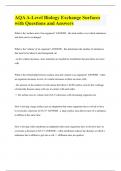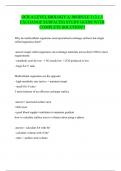Exchange surfaces - Study guides, Class notes & Summaries
Looking for the best study guides, study notes and summaries about Exchange surfaces? On this page you'll find 2066 study documents about Exchange surfaces.
All 2.066 results
Sort by
 Popular
Popular
-
Solutions for Thermal Radiation Heat Transfer, 7th Edition Howell (All Chapters included)
- Exam (elaborations) • 393 pages • 2024
-
- $29.49
- 4x sold
- + learn more
Complete Solutions Manual for Thermal Radiation Heat Transfer, 7th Edition by John R. Howell, M. Pinar Mengüc, Kyle Daun, Robert Siegel ; ISBN13: 9780367347079. (Full Chapters included Chapter 1 to 19).... 1. Introduction to Radiative Transfer. 2. Radiative Properties at Interfaces. 3. Radiative Properties of Opaque Materials. 4. Configuration Factors for Diffuse Surfaces with Uniform Radiosity. 5. Radiation Exchange in Enclosures Composed of Black and/or Diffuse–Gray Surfaces. 6. Exchange o...
 Popular
Popular
-
CBSPD Exam 2024 Questions & Answers 100% Correct | Verified
- Exam (elaborations) • 12 pages • 2024 Popular
-
Available in package deal
-
- $7.99
- 1x sold
- + learn more
CBSPD Exam 2024 Questions & Answers | 100% Correct | Verified What should the sterilizer access area pressure be? - Negative w/10 air exchanges per hour What two steps are involved in decontamination? - 1. Manual and/or automated mechanical cleaning 2. application of a thermal or chemical disinfection process Define Cleaning... - The removal of contamination from an item to the extent necessary for further processing or for the intended use. nosocomial infections are well documented and...

-
EXCHANGE SURFACES VERIFIED SOLUTIONS 2023/2024
- Exam (elaborations) • 24 pages • 2024
-
- $13.99
- + learn more
EXCHANGE SURFACES VERIFIED SOLUTIONS 2023/2024 Why do multicellular organisms need specialised exchange surfaces but single celled organisms don't? - ANSWER single celled organisms can exchange materials across their CSM to meet requirements - metabolic activity low → O2 needs low + CO2 produced is low - large SA:V ratio Multicellular organisms are the opposite - high metabolic rate (active + maintain temp) - small SA:V ratio 3 main features of an efficient exchange surface - ...

-
EXCHANGE SURFACES VERIFIED SOLUTIONS 2023/2024
- Exam (elaborations) • 24 pages • 2024
-
- $13.99
- + learn more
EXCHANGE SURFACES VERIFIED SOLUTIONS 2023/2024 Why do multicellular organisms need specialised exchange surfaces but single celled organisms don't? - ANSWER single celled organisms can exchange materials across their CSM to meet requirements - metabolic activity low → O2 needs low + CO2 produced is low - large SA:V ratio Multicellular organisms are the opposite - high metabolic rate (active + maintain temp) - small SA:V ratio 3 main features of an efficient exchange surface - ...
OCR A LEVEL BIOLOGY A: MODULE 3 (3.1.1 EXCHANGE SURFACES) STUDY GUIDE WITH COMPLETE SOLUTION!!

-
2024 EXCHANGE SURFACES EXAM WITH VERIFIED SOLUTIONS
- Exam (elaborations) • 24 pages • 2024
-
- $12.49
- + learn more
Why do multicellular organisms need specialised exchange surfaces but single celled organisms don't? - ANSWER single celled organisms can exchange materials across their CSM to meet requirements - metabolic activity low → O2 needs low + CO2 produced is low - large SA:V ratio Multicellular organisms are the opposite - high metabolic rate (active + maintain temp) - small SA:V ratio 3 main features of an efficient exchange surface - ANSWER • increased surface area • thin layer • ...

-
OCR A-level Biology 3.1.1 Exchange Surfaces | 58 Questions with 100% correct Answers | Verified
- Exam (elaborations) • 6 pages • 2023
- Available in package deal
-
- $3.99
- + learn more
Metabolism - All of the chemical reactions that occur within an organism what is the need for specialised exchange surfaces? - multi-cellular organisms have a small surface area to volume ratio, they have increased metabolic rate, distance gases have to travel is further Specialised Exchange Surfaces adaptations - Increased surface area Thin gas exchange surface Good blood supply Ventilation to maintain diffusion gradient moist gas exchange surface (gases can dissolve) Explain how the al...

-
AQA A-Level Biology Exchange Surfaces with Questions and Answers
- Exam (elaborations) • 22 pages • 2024
-
Available in package deal
-
- $7.19
- + learn more
AQA A-Level Biology Exchange Surfaces with Questions and Answers What is the 'surface area' of an organism? ANSWER - the total surface over which substances and heat can be exchanged What is the 'volume' of an organism? ANSWER - this determines the number of substances that need to be taken in and transported out - as the volume increases, more materials are needed for metabolism because there are more cells What is the relationship between surface area and volume in an organism? A...

-
EXCHANGE SURFACES VERIFIED SOLUTIONS 2023/2024
- Exam (elaborations) • 24 pages • 2023
-
- $10.49
- + learn more
EXCHANGE SURFACES VERIFIED SOLUTIONS 2023/2024 Why do multicellular organisms need specialised exchange surfaces but single celled organisms don't? - ANSWER single celled organisms can exchange materials across their CSM to meet requirements - metabolic activity low → O2 needs low + CO2 produced is low - large SA:V ratio Multicellular organisms are the opposite - high metabolic rate (active + maintain temp) - small SA:V ratio 3 main features of an efficient exchange surface - ...

-
EXCHANGE SURFACES VERIFIED SOLUTIONS 2023/2024
- Exam (elaborations) • 24 pages • 2024
-
- $13.99
- + learn more
EXCHANGE SURFACES VERIFIED SOLUTIONS 2023/2024 Why do multicellular organisms need specialised exchange surfaces but single celled organisms don't? - ANSWER single celled organisms can exchange materials across their CSM to meet requirements - metabolic activity low → O2 needs low + CO2 produced is low - large SA:V ratio Multicellular organisms are the opposite - high metabolic rate (active + maintain temp) - small SA:V ratio 3 main features of an efficient exchange surface - ...

-
AAOS Chapter 2 EMT Eleventh Edition - Workforce Safety and Wellness fully solved graded A+ 2023
- Exam (elaborations) • 7 pages • 2023
- Available in package deal
-
- $11.49
- 1x sold
- + learn more
AAOS Chapter 2 EMT Eleventh Edition - Workforce Safety and WellnessVector-borne transmission of an infectious organism occurs via: - correct answer animals or insects. Which of the following statements regarding the different stages of the grieving process is correct? - correct answer The stages of the grieving process may occur simultaneously. Common factors that influence how a patient reacts to the stress of an illness or injury include all of the following, EXCEPT: - correct answer ass...

How much did you already spend on Stuvia? Imagine there are plenty more of you out there paying for study notes, but this time YOU are the seller. Ka-ching! Discover all about earning on Stuvia



